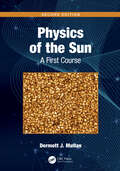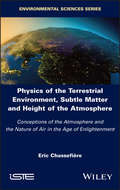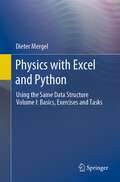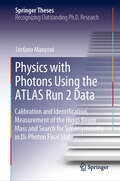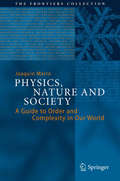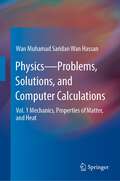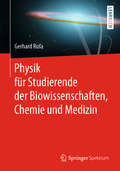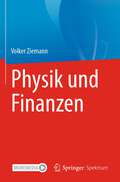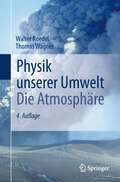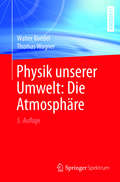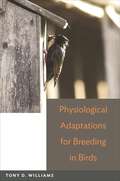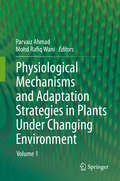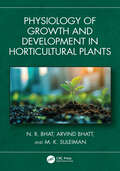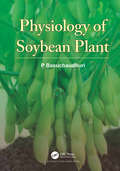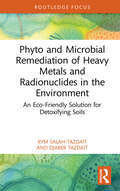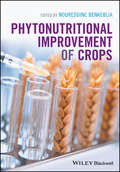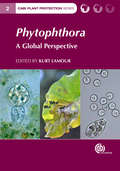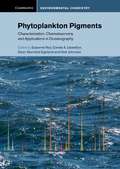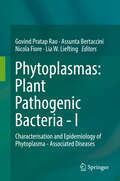- Table View
- List View
Physics of the Earth
by Frank D Stacey Paul M DavisThe fourth edition of Physics of the Earth maintains the original philosophy of this classic graduate textbook on fundamental solid earth geophysics, while being completely revised, updated, and restructured into a more modular format to make individual topics even more accessible. Building on the success of previous editions, which have served generations of students and researchers for nearly forty years, this new edition will be an invaluable resource for graduate students looking for the necessary physical and mathematical foundations to embark on their own research careers in geophysics. Several completely new chapters have been added and a series of appendices, presenting fundamental data and advanced mathematical concepts, and an extensive reference list, are provided as tools to aid readers wishing to pursue topics beyond the level of the book. Over 140 student exercises of varying levels of difficulty are also included, and full solutions are available online at www. cambridge. org/9780521873628.
Physics of the Sun: A First Course
by Dermott J. MullanWith an emphasis on numerical modelling, Physics of the Sun: A First Course presents a quantitative examination of the physical structure of the Sun and the conditions of its extended atmosphere. It gives step-by-step instructions for calculating the numerical values of various physical quantities in different regions of the Sun. Fully updated throughout, with the latest results in solar physics, this second edition covers a wide range of topics on the Sun and stellar astrophysics, including the structure of the Sun, solar radiation, the solar atmosphere, and Sun-space interactions. It explores how the physical conditions in the visible surface of the Sun are determined by the opacity of the material in the atmosphere. It also presents the empirical properties of convection in the Sun, discusses the physical conditions which must be satisfied for nuclear reactions to occur in the core, and describes how radiation transports energy from the core outwards. This text enables a practical appreciation of the physical models of solar processes. Numerical modelling problems and step-by-step instructions are featured throughout, to empower students to calculate, using their own codes, the interior structure of different parts of the Sun and the frequencies of p-modes and g-modes. They encourage a firm grasp of the numerical values of actual physical parameters as a function of radial location in the Sun. It is an ideal introduction to solar physics for advanced undergraduate and graduate students in physics and astronomy, in addition to research professionals looking to incorporate modelling into their practises. Extensive bibliographies at the end of each chapter enable the reader to explore the latest research articles in the field. Features Fully updated with the latest results from the spacecraft Hinode, Stereo, Solar Dynamics Observatory (SDO), Interface Region Imaging Spectrograph (IRIS), and Parker Solar Probe Presents step-by-step explanations for calculating numerical models of the photosphere, convection zone, and radiative interior with exercises and simulation problems to test learning Describes the structure of polytropic spheres and the acoustic power in the Sun and the process of thermal conduction in different physical conditions
Physics of the Terrestrial Environment, Subtle Matter and Height of the Atmosphere: Conceptions of the Atmosphere and the Nature of Air in the Age of Enlightenment
by Eric ChassefiereThe discovery, in the middle of the 17th century, of both the weight of air and the law governing its elasticity transformed the status of the atmosphere from that of a purely mathematical object to that of a complex and highly variable physical system.In the context of rapidly intensifying experimentation and observation, the nature of the atmosphere was therefore the subject of a host of hypotheses, which 18th century scholars tried to reconcile with a coherent physical approach. In particular, this was achieved by the conceptualization of invisible or “subtle” materials, thought to be closely linked to atmospheric stratification.Subtle matter was introduced, largely to reconcile contradictory results concerning the estimation of the height of the atmosphere. These estimations were based on different methods, mainly using the observation of meteors and the refracted and reflected light of stars.Taking as its common thread the question of the height of the atmosphere, which was omnipresent in the texts at the time, this book traces the history of the discovery of the atmosphere and the many questions it generated.
Physics with Excel and Python: Using the Same Data Structure Volume I: Basics, Exercises and Tasks
by Dieter MergelThis book is intended to serve as a basic introduction to scientific computing by treating problems from various areas of physics - mechanics, optics, acoustics, and statistical reasoning in the context of the evaluation of measurements. After working through these examples, students are able to independently work on physical problems that they encounter during their studies. For every exercise, the author introduces the physical problem together with a data structure that serves as an interface to programming in Excel and Python. When a solution is achieved in one application, it can easily be translated into the other one and presumably any other platform for scientific computing. This is possible because the basic techniques of vector and matrix calculation and array broadcasting are also achieved with spreadsheet techniques, and logical queries and for-loops operate on spreadsheets from simple Visual Basic macros. So, starting to learn scientific calculation with Excel, e.g., at High School, is a targeted road to scientific computing. The primary target groups of this book are students with a major or minor subject in physics, who have interest in computational techniques and at the same time want to deepen their knowledge of physics. Math, physics and computer science teachers and Teacher Education students will also find a companion in this book to help them integrate computer techniques into their lessons. Even professional physicists who want to venture into Scientific Computing may appreciate this book.
Physics with Photons Using the ATLAS Run 2 Data: Calibration and Identification, Measurement of the Higgs Boson Mass and Search for Supersymmetry in Di-Photon Final State (Springer Theses)
by Stefano ManzoniThe work presented in this book is based on the proton-proton collision data from the Large Hadron Collider at a centre-of-mass energy of 13 TeV recorded by the ATLAS detector in 2015 and 2016. The research program of the ATLAS experiment includes the precise measurement of the parameters of the Standard Model, and the search for signals of physics beyond the SM. Both these approaches are pursued in this thesis, which presents two different analyses: the measurement of the Higgs boson mass in the di-photon decay channel, and the search for production of supersymmetric particles (gluinos, squarks or winos) in a final state containing two photons and missing transverse momentum. Finally, ATLAS detector performance studies, which are key ingredients for the two analyses outlined before, are also carried out and described.
Physics, Nature and Society: A Guide to Order and Complexity in Our World (The Frontiers Collection)
by Joaquín MarroThis wide-ranging and accessible book serves as a fascinating guide to the strategies and concepts that help us understand the boundaries between physics, on the one hand, and sociology, economics, and biology on the other. From cooperation and criticality to flock dynamics and fractals, the author addresses many of the topics belonging to the broad theme of complexity. He chooses excellent examples (requiring no prior mathematical knowledge) to illuminate these ideas and their implications. The lively style and clear description of the relevant models will appeal both to novices and those with an existing knowledge of the field.
Physics—Problems, Solutions, and Computer Calculations: Vol. 1 Mechanics, Properties of Matter, and Heat
by Wan Muhamad Wan HassanKnowledge of and skill in physics are essential foundations for studies in science and engineering. This book offers students an introduction to the basic concepts and principles of physics. It covers various topics specifically related to physical mechanics, the properties of matter, and heat. Each chapter begins with a summary of concepts, principles, definitions, and formulae to be discussed, as well as ending with problems and solutions that illustrate the specific topic. Steps are detailed to help build reasoning and understanding. There are 300 worked problems and 100 exercises in the book, as well as 306 figures to help the reader visualize the processes being addressed. Computer calculations and solutions are carried out using wxMaxima to give insight and help build computational skills. The book is aimed at first-year undergraduate students studying introductory physics, and would also be useful for physics teachers in their instruction, particularly the exercises at the end of each chapter.
Physik für Studierende der Biowissenschaften, Chemie und Medizin
by Gerhard RufaDieses Lehrbuch bietet eine klar strukturierte Einführung in die Physik, wobei die Grundlagen, wie sie für Studierende mit Physik im Nebenfach benötigt werden, in einer leicht verständlichen Weise dargestellt werden. Die physikalischen Begriffe und Gesetzmäßigkeiten werden anhand vieler Abbildungen sowie durch Beispiele aus dem täglichen Leben, den Biowissenschaften, der Chemie und der Medizin erläutert. Vorkenntnisse aus der Physik werden nicht vorausgesetzt, sodass Studierende sich selbstständig das physikalische Grundlagenwissen erarbeiten können und ein Verständnis der abstrakten physikalischen Begriffe und Gesetzmäßigkeiten erhalten.Ergänzt wird dieses Lehrbuch von dem separaten Übungsbuch Physik für Studierende der Biowissenschaften, Chemie und Medizin, das eine Vielzahl von Übungsserien und Testserien mit ausführlichen Lösungen und Erklärungen enthält. Es hilft Studierenden, sich anhand ausgewählter physikalischer Probleme Schritt für Schritt die Physik und auch die erforderliche Mathematik zu erarbeiten. Beide Bücher eignen sich somit hervorragend als Ergänzung zur Vorlesung sowie für die Klausurvorbereitung.
Physik und Finanzen
by Volker ZiemannDieses Buch führt Physikstudenten in die Konzepte und Methoden der Finanzwissenschaft ein. Obwohl die Finanzwissenschaft als recht weit von der Physik entfernt wahrgenommen wird, teilt sie eine Reihe gemeinsamer Methoden und Ideen, die in der Regel mit Rauschen und Unsicherheiten zu tun haben. Durch die Gegenüberstellung der wichtigsten Methoden mit Anwendungen in der Physik und im Finanzwesen werden sowohl die Unterschiede als auch die Gemeinsamkeiten deutlich, was den Studierenden ein tieferes Verständnis der zugrunde liegenden Ideen vermittelt. Darüber hinaus lernen sie eine Reihe nützlicher mathematischer und rechnerischer Werkzeuge kennen, wie stochastische Differentialgleichungen, Pfadintegrale, Monte-Carlo-Methoden und grundlegende Kryptologie. Jedes Kapitel endet mit einer Reihe sorgfältig ausgearbeiteter Übungen, mit denen die Leser ihr Verständnis überprüfen können.
Physik unserer Umwelt: Die Atmosphäre
by Thomas Wagner Walter RoedelDas Buch basiert auf einer zweisemestrigen Vorlesung an der Universität Heidelberg über die Physik der Atmosphäre. Der Autor erklärt einerseits das System Atmosphäre und vermittelt andererseits umweltrelevante Aspekte. Die Neuauflage wurde zum Teil grundlegend überarbeitet. So wurden für die Kapitel zu Spurenstoffen und zur Klimamodellierung die neuesten Forschungserkenntnisse eingearbeitet, das Kapitel über Aerosole um Abschnitte zu deren chemischer Bedeutung ergänzt. Mit umfangreichem Register sowie ausführlichen Quellen- und Literaturangaben.
Physik unserer Umwelt: Die Atmosphäre
by Thomas Wagner Walter RoedelDas Buch basiert auf einer zweisemestrigen Vorlesung an der Universität Heidelberg über die Physik der Atmosphäre. Der Autor erklärt einerseits das System Atmosphäre und vermittelt andererseits umweltrelevante Aspekte. Die Neuauflage wurde zum Teil grundlegend überarbeitet. So wurden für die Kapitel zu Spurenstoffen und zur Klimamodellierung die neuesten Forschungserkenntnisse eingearbeitet, das Kapitel über Aerosole um Abschnitte zu deren chemischer Bedeutung ergänzt. Mit umfangreichem Register sowie ausführlichen Quellen- und Literaturangaben.
Physik unserer Umwelt: Die Atmosphäre
by Thomas Wagner Walter RoedelDas vorliegende Lehrbuch bietet eine Einführung in die Physik der Atmosphäre, wie sie im Rahmen der Umweltphysik gelehrt wird. Zuerst wird dem Leser die Funktionsweise des Systems Atmosphäre verständlich gemacht. Dazu werden Themen wie Strahlungs- und Energiehaushalt, atmosphärische Dynamik, Zirkulationen, Niederschlagsbildung und der Wasserkreislauf behandelt. Zudem werden die umweltrelevanten Aspekte der Meteorologie und der Atmosphärenphysik herausgearbeitet. Hierzu dienen unter anderem eine ausführliche Darstellung von Diffusions- und Transportprozessen sowie zahlreiche Abschnitte über das Verhalten von Spurenstoffen, mit Schwerpunkt auf strahlungsrelevanten Spurengasen und Aerosolen. Eine Diskussion von Klima-Entwicklungen und deren Bewertung rundet den Inhalt ab und bietet damit einen umfassenden Überblick über das Thema. Änderungen gegenüber der 5. Auflage betreffen insbesondere die letzten 3 Kapitel. Einerseits wurde in den letzten 6 Jahren eine Vielzahl neuer Forschungsergebnisse verfügbar. Andererseits hat sich in diesem Zeitraum auch der Zustand unseres Planeten weiter dramatisch verändert. In der neuen Auflage werden hierzu die neuesten verfügbaren Messdaten und Studien berücksichtigt. Das Buch wendet sich ebenso an Studierende der Physik und der Geowissenschaften wie an Wissenschaftler(innen) und Lehrer(innen), die sich für ihre berufliche Arbeit eine Einführung in die atmosphärische Physik und in die Umweltmeteorologie wünschen. Ein umfangreiches Register ermöglicht das schnelle Auffinden eines Themas, die große Zahl von Quellen- und Literaturangaben erleichtert den Zugang zu weiteren Informationen.
Physiological Adaptations for Breeding in Birds
by Tony D. WilliamsPhysiological Adaptations for Breeding in Birds is the most current and comprehensive account of research on avian reproduction. It develops two unique themes: the consideration of female avian reproductive physiology and ecology, and an emphasis on individual variation in life-history traits. Tony Williams investigates the physiological, metabolic, energetic, and hormonal mechanisms that underpin individual variation in the key female-specific reproductive traits and the trade-offs between these traits that determine variation in fitness.The core of the book deals with the avian reproductive cycle, from seasonal gonadal development, through egg laying and incubation, to chick rearing. Reproduction is considered in the context of the annual cycle and through an individual's entire life history. The book focuses on timing of breeding, clutch size, egg size and egg quality, and parental care. It also provides a primer on female reproductive physiology and considers trade-offs and carryover effects between reproduction and other life-history stages. In each chapter, Williams describes individual variation in the trait of interest and the evolutionary context for trait variation. He argues that there is only a rudimentary, and in some cases nonexistent, understanding of the physiological mechanisms that underpin individual variation in the major reproductive life-history traits, and that research efforts should refocus on these key unresolved problems by incorporating detailed physiological studies into existing long-term population studies, generating a new synthesis of physiology, ecology, and evolutionary biology.
Physiological Mechanisms and Adaptation Strategies in Plants Under Changing Environment
by Parvaiz Ahmad Mohd Rafiq WaniAbiotic stress has a detrimental impact on the living organisms in a specific environment and constitutes a major constraint to global agricultural production. The adverse environmental conditions that plants encounter during their life cycle not only disturb their metabolic reactions, but also hamper their growth and development on cellular and whole plant levels. These conditions are of great concern, particularly for those countries whose economies primarily rely on agriculture. Under abiotic stresses, plants amalgamate multiple external stress cues to bring about a coordinated response and establish mechanisms to mitigate such stresses by triggering a cascade of events leading to enhanced tolerance. Physiological Mechanisms and Adaptation Strategies in Plants under Changing Environment, Volume 2 displays the ways by which plants utilize and integrate many common signals and subsequent pathways to cope with less favourable environmental conditions. The book also describes the use of contemporary tools for the improvement of plants under such stressed environments. Concise yet comprehensive, Physiological Mechanisms and Adaptation Strategies in Plants under Changing Environment, Volume 2 is an indispensable resource for researchers, students, environmentalists and many others in this burgeoning area of research.
Physiology of Growth and Development in Horticultural Plants
by N. R. Bhat Arvind Bhatt M. K. SuleimanThe development of a plant is a multifaceted, dynamic phenomenon. Due to their immobility, plants respond not only to internal developmental cues, but also to changes in the prevailing environmental conditions. Climate change has increased vulnerability in plants due to increasing concentrations of CO2 and other pollutants, and fluctuations in the growing environment. These changes affect crop growth and productivity thereby posing a major risk to global food security. Physiology of Growth and Development in Horticultural Plants contains 22 chapters organized into six sections, beginning with an introduction on basic concepts of plant growth and development; followed by genetic basis of plant development; quantification of growth; and sensing and response of plants to various environmental signals. It also explores plant growth hormones and their role either singly or in combination in controlling various aspects of plant growth and development, and hormonal regulation of physiological and developmental processes. The book highlights intricate aspects of growth and development in horticultural plants with classic examples from the real world.Features· Presents information on plant growth and development; structure and genetic basis of plant development with quantification of growth; sensing and response of plants to various environmental signals; and various phytohormones and their role in controlling aspects of plant growth and development.· Provides key scientific and technical advances, issues, and challenges in various areas of growth and development of horticultural plants.· Demonstrates how the response of various plants to internal and external stimuli can be commercially exploited.Physiology of Growth and Development in Horticultural Plants encourages the development of new techniques, technologies and innovative practices, and is an ideal reference for students of advanced plant sciences courses, researchers, and commercial horticultural practitioners.
Physiology of Marine Mammals: Adaptations to the Ocean (CRC Marine Biology Series)
by Michael A. Castellini Jo-Ann MellishSuppose you were designing a marine mammal. What would they need to live in the ocean? How would you keep them warm? What design features would allow them to dive for very long periods to extreme depths? Do they need water to drink? How would they minimize the cost of swimming, and how would they find their prey in the deep and dark? These questions and more are examined in detail throughout Marine Mammal Physiology, which explores how marine mammals live in the sea from a physiological point of view. This undergraduate textbook considers the essential aspects of what makes a marine mammal different from terrestrial mammals, beyond just their environment. It focuses on the physiological and biochemical traits that have allowed this group of mammals to effectively exploit the marine environment that is so hostile to humans. The content of this book is organised around common student questions, taking the undergraduate's point of view as the starting point. Each chapter provides a set of PowerPoint slides for instructors to use in teaching and students to use as study guides. New "Study Questions" and "Critical Thinking Points" conclude each chapter, which are each motivated by a "Driving Question" such as "How do mammals stay warm in a cold ocean?" or "How do mammals survive the crushing pressures of the deep sea?" Full-colour images and comprehensive, accessible content make this the definitive textbook for marine mammal physiology.
Physiology of Soybean Plant
by P BasuchaudhuriThe book provides in-depth knowledge on the physiology of soybean. It is written lucidly, systematically, and in depth. The book provides recent information and findings, explained with illustrations to express the ideas and concepts vividly to university students and researchers, and provides a better understanding of the improvement of the productivity of soybean to cope with the future demand. It describes the physiology of growth, development, flowering, pod development and seed yield as well as C, O, N and Oil metabolisms – their hormonal regulations under normal and stress environmental conditions. Molecular approaches are also described.
Phyto and Microbial Remediation of Heavy Metals and Radionuclides in the Environment: An Eco-Friendly Solution for Detoxifying Soils (Routledge Focus on Environment and Sustainability)
by Rym Salah-Tazdaït Djaber TazdaïtThis book examines the role that bioremediation can play in the detoxification of soil, water, and air to improve environmental and human health, with a specific focus on heavy metals and radionuclides. Environmental pollution, whether by natural or human causes, with industrial activities being a key player, is a challenge facing all nations across the world. While treatment has typically required the use of expensive technology, one promising solution is the use of phytoremediation, in which plants act by metabolizing or sequestering pollutants. This eco-friendly solution is a good alternative to the standard methods of soil and water treatments. This book provides not only the basic definitions and classification of technologies used for contaminant remediation but also the most recent studies dealing with the selection of new promising microbial stains and plant varieties involved in the treatment of radioactive and heavy metal contaminants. It provides a detailed description of the biochemical mechanisms and genes involved in the bioremediation of radionuclides and heavy metals, offering a clear insight for academics and practitioners interested in in vitro and in situ biological treatment. This book will be of great value to students and scholars interested in environmental pollution and environmental health from across a range of different disciplines, including environmental microbiology and chemistry, ecology and environmental science, biological and environmental engineering and biotechnology.
Phyto and Rhizo Remediation (Microorganisms for Sustainability #9)
by Narendra Kumar Naveen Kumar AroraThe increasing human population and the associated activities have negatively influenced the ecosystems and life on earth. The continuous addition of agrochemicals, heavy metals and industrial wastes/ effluents in the ecosystems have caused great harm, including loss of productivity, biodiversity, climate change and diseases in plants, animals and humans, resulting in increased marginal lands and endangered sustainability of life on earth. Hence, there is an urgent need to reverse the impact of dangerous pollutants through a holistic, sustainable and biotic approach. Bioremediation involves the utilization of biological systems, mainly plants (phytoremediation) or microorganisms or both in combination (rhizoremediation) for the removal or degradation of pollutants and revive the habitats in an eco-friendly manner. Recently, there have been many success stories related to bioremediation involving plants or plant-microbe interactions. These success stories are related to the removal of heavy metals, pesticides, polyaromatic hydrocarbons, explosives, radionuclides or reduction of biological oxygen demand, total dissolved solids, total suspended solids, oil spills in water bodies. Rhizoremediation has also been successfully used for reclamation of saline or marginal soils. With the range of pollutants and the total area (on earth) covered by these toxic chemicals, it is important that these eco-friendly technologies be utilized in a better way. The book throws light on the recent happenings, research and success stories related to bioremediation of polluted habitats through phytoremediation or rhizoremediation. The book also highlights some of the significantly important plant and microbial species involved in remediation, the physiology, biochemistry and the mechanisms of remediation by various plants and microbes, and suggestions for future improvement of bioremediation technology.
Phytonutritional Improvement of Crops
by Noureddine BenkebliaAn in-depth treatment of cutting-edge work being done internationally to develop new techniques in crop nutritional quality improvement Phytonutritional Improvement of Crops explores recent advances in biotechnological methods for the nutritional enrichment of food crops. Featuring contributions from an international group of experts in the field, it provides cutting-edge information on techniques of immense importance to academic, professional and commercial operations. World population is now estimated to be 7.5 billion people, with an annual growth rate of nearly 1.5%. Clearly, the need to enhance not only the quantity of food produced but its quality has never been greater, especially among less developed nations. Genetic manipulation offers the best prospect for achieving that goal. As many fruit crops provide proven health benefits, research efforts need to be focused on improving the nutritional qualities of fruits and vegetables through increased synthesis of lycopene and beta carotene, anthocyanins and some phenolics known to be strong antioxidants. Despite tremendous growth in the area occurring over the past several decades, the work has only just begun. This book represents an effort to address the urgent need to promote those efforts and to mobilise the tools of biotechnical and genetic engineering of the major food crops. Topics covered include: New applications of RNA-interference and virus induced gene silencing (VIGS) for nutritional genomics in crop plants Biotechnological techniques for enhancing carotenoid in crops and their implications for both human health and sustainable development Progress being made in the enrichment and metabolic profiling of diverse carotenoids in a range of fruit crops, including tomatoes, sweet potatoes and tropical fruits Biotechnologies for boosting the phytonutritional values of key crops, including grapes and sweet potatoes Recent progress in the development of transgenic rice engineered to massively accumulate flavonoids in-seed Phytonutritional Improvement of Crops is an important text/reference that belongs in all universities and research establishments where agriculture, horticulture, biological sciences, and food science and technology are studied, taught and applied.
Phytophthora
by Frank Martin Greg Forbes Marco Thines Yilmaz Balci Yuanchao Wang Kurt Lamour Sylvia Patricia Fernández Pavía Mary Hausbeck Paul Bosland Thomas Jung Olaf Ribeiro Randy Ploetz Adrienne Hardham Janice Uchida Anne Dorrance Tibor Érsek Jan Nagel Dennis Halterman Soum Sanago Susan Miyasaka David Cooke Andre Drenth Rodrigo Ahumada Sabine WerresMembers of the genus Phytophthora cause serious damage to a huge array of plants. From the nineteenth century Irish potato famine to current widespread threats to forests and ecosystems in North and South America, Europe and Australia, the genus lives up to its reputation as the plant destroyer. This book provides an overview of Phytophthora species impacting crops, forests, nurseries, greenhouses and natural areas worldwide. Chapters cover major hosts, identification, epidemiology, management, current research, future perspectives and the impacts of globalization on Phytophthora. Phytophthora: A Global Perspective is an essential resource for researchers and extension workers in plant pathology and crop protection.
Phytophthora: A Global Perspective (Plant Science / Horticulture Ser. #2)
by Frank Martin Greg Forbes Marco Thines Yilmaz Balci Yuanchao Wang Sylvia Patricia Fernández Pavía Mary Hausbeck Paul Bosland Thomas Jung Olaf Ribeiro Randy Ploetz Adrienne Hardham Janice Uchida Anne Dorrance Tibor Érsek Jan Nagel Dennis Halterman Soum Sanago Susan Miyasaka David Cooke Andre Drenth Rodrigo Ahumada Sabine WerresMembers of the genus Phytophthora cause serious damage to a huge array of plants. From the nineteenth century Irish potato famine to current widespread threats to forests and ecosystems in North and South America, Europe and Australia, the genus lives up to its reputation as the plant destroyer. This book provides an overview of Phytophthora species impacting crops, forests, nurseries, greenhouses and natural areas worldwide. Chapters cover major hosts, identification, epidemiology, management, current research, future perspectives and the impacts of globalization on Phytophthora. Phytophthora: A Global Perspective is an essential resource for researchers and extension workers in plant pathology and crop protection.
Phytoplankton Pigments
by Suzanne Roy Einar Skarstad Egeland Geir Johnsen Carole A. LlewellynPigments act as tracers to elucidate the fate of phytoplankton in the world's oceans and are often associated with important biogeochemical cycles related to carbon dynamics in the oceans. They are increasingly used in in situ and remote-sensing applications, detecting algal biomass and major taxa through changes in water colour. This book is a follow-up to the 1997 volume Phytoplankton Pigments in Oceanography (UNESCO Press). Since then, there have been many advances concerning phytoplankton pigments. This book includes recent discoveries on several new algal classes particularly for the picoplankton, and on new pigments. It also includes many advances in methodologies, including liquid chromatography-mass spectrometry (LC-MS) and developments and updates on the mathematical methods used to exploit pigment information and extract the composition of phytoplankton communities. The book is invaluable primarily as a reference for students, researchers and professionals in aquatic science, biogeochemistry and remote sensing.
Phytoplankton Pigments
by Suzanne Roy Einar Skarstad Egeland Carole Llewellyn Geir JohnsenPigments act as tracers to elucidate the fate of phytoplankton in the world's oceans and are often associated with important biogeochemical cycles related to carbon dynamics in the oceans. They are increasingly used in in situ and remote-sensing applications, detecting algal biomass and major taxa through changes in water colour. This book is a follow-up to the 1997 volume Phytoplankton Pigments in Oceanography (UNESCO Press). Since then, there have been many advances concerning phytoplankton pigments. This book includes recent discoveries on several new algal classes particularly for the picoplankton, and on new pigments. It also includes many advances in methodologies, including liquid chromatography-mass spectrometry (LC-MS) and developments and updates on the mathematical methods used to exploit pigment information and extract the composition of phytoplankton communities. The book is invaluable primarily as a reference for students, researchers and professionals in aquatic science, biogeochemistry and remote sensing.
Phytoplasmas: Characterisation And Epidemiology Of Phytoplasma - Associated Diseases
by Assunta Bertaccini Govind Pratap Rao Nicola Fiore Lia W. LieftingPhytoplasma-associated diseases are a major limiting factor to quality and productivity of many ornamentals, horticultural and other economically important agriculture crops worldwide. Annual losses due to phytoplasma diseases in many crops vary, but under the pathogen favorable conditions they always lead to disastrous consequences to farming community. As there is no effective cure for phytoplasma diseases, the management options emphasize on their exclusion, minimizing their spread by insect vectors and propagation materials and on development of host plant resistance. The phytoplasma associated plant diseases have a history of more than 50 years. Phytoplasmas have undoubtedly infected plants and cause diseases for centuries before they are described and proven to be the causal agents. But important progress related to identification of phytoplasmas only began after 1980’s. Phytoplasmas have emerged as the most serious constraints in the production of several crops all around the world during last four decades. Phytoplasmas constitute a major limiting factor to quality and productivity of cereals, horticultural, ornamentals and many other economically important crops all over the world. Annual losses due to phytoplasma diseases may vary, but under the pathogen favorable condition, phytoplasma disease may lead to disastrous consequences for farming and industry community. The scientific literature concerning phytoplasma occurrence, characterization, diagnosis, detection, and management is growing at a fast pace. Significant advancement in the last decades on diagnostic, biological and molecular properties, epidemiology, host-pathogen-insect interactions as well as management of phytoplasmas has been made. Till date, no authentic compilation is available to know the progress of phytoplasmas characterization major crops all over the world. The planned book will compile all the updated information available information on phytoplasmas by distinguished experts in the form of edited book entitled “Characterization and epidemiology of phytoplasma associated diseases”. The book covers recent and update information on emerging and re-emerging phytoplasma diseases affecting important crops in tropics and subtropics. It provides comprehensive information on disease distribution, occurrence, and identification of the phytoplasmas including the recent approaches for diagnostics, transmission, and information about losses and geographical distribution along with and management aspects. This volume contains 11-12 chapters contributed by the experienced and recognized experts working on different group of phytoplasmas affecting major crops all over the world. The information on various topics is at advanced as well as comprehensive level and provides the period wise developments of phytoplasma research. The book covers major chapters on an up to date progress of phytoplasma research, and then phytoplasma diseases associated with vegetable, pulse, oils crops, cereals, sugar crops, fruit crops, ornamentals, medicinal plants, palms species, forest tress and weeds. We have covered historical background, geographical distribution, identification and characterization, genetic diversity, host pathogen interaction and management aspects of important phytoplasma diseases infecting our major agricultural crops. The information on various topics is advanced as well as comprehensive, and provides thought provoking ideas for planning novel research ideas for future. This book will be useful to everyone interested in mollicutes, phytoplasma, spiroplasmas, plant pathology, disease control and plant biology and serve as an exhaustive and up-to-date compendium of references on various aspects of different groups of phytoplasmas affecting important crops worldwide.

